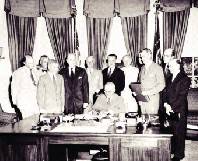
The North Atlantic Treaty Organization was created in 1949 by the United States, Canada, and several Western European nations to provide collective security against the Soviet Union.
NATO was the first peacetime military alliance the United States entered into outside of the Western Hemisphere. After the destruction of the Second World War, the nations of Europe struggled to rebuild their economies and ensure their security. The former required a massive influx of aid to help the war-torn landscapes re-establish industries and produce food, and the latter required assurances against a resurgent Germany or incursions from the Soviet Union. The United States viewed an economically strong, rearmed, and integrated Europe as vital to the prevention of communist expansion across the continent. As a result, Secretary of State George Marshall proposed a program of large-scale economic aid to Europe. The resulting European Recovery Program, or Marshall Plan, not only facilitated European economic integration but promoted the idea of shared interests and cooperation between the United States and Europe. Soviet refusal either to participate in the Marshall Plan or to allow its satellite states in Eastern Europe to accept the economic assistance helped to reinforce the growing division between east and west in Europe.
The Western European countries were also willing to consider a collective security solution. In response to increasing tensions and security concerns, representatives of several countries of Western Europe gathered together to create a military alliance. Great Britain, France, Belgium, the Netherlands and Luxembourg signed the Brussels Treaty in March, 1948. Their treaty provided collective defense; if any one of these nations was attacked, the others were bound to help defend it. At the same time, the Truman Administration instituted a peacetime draft, increased military spending, and called upon the historically isolationist Republican Congress to consider a military alliance with Europe. In May of 1948, Republican Senator Arthur H. Vandenburg proposed a resolution suggesting that the President seek a security treaty with Western Europe that would adhere to the United Nations charter but exist outside of the Security Council where the Soviet Union held veto power. The Vandenburg Resolution passed, and negotiations began for the North Atlantic Treaty.
In spite of general agreement on the concept behind the treaty, it took several months to work out the exact terms.
The result of extensive negotiations was the signing of the North Atlantic Treaty in 1949. In this agreement, the United States, Canada, Belgium, Denmark, France, Iceland, Italy, Luxemburg, the Netherlands, Norway, Portugal, and the United Kingdom agreed to consider attack against one an attack against all, along with consultations about threats and defense matters. This collective defense arrangement only formally applied to attacks against the signatories that occurred in Europe or North America; it did not include conflicts in colonial territories.
The collective defense arrangements in NATO served to place the whole of Western Europe under the American “nuclear umbrella.” In the 1950s, one of the first military doctrines of NATO emerged in the form of “massive retaliation,” or the idea that if any member was attacked, the United States would respond with a large-scale nuclear attack. The threat of this form of response was meant to serve as a deterrent against Soviet aggression on the continent. Although formed in response to the exigencies of the developing Cold War, NATO has lasted beyond the end of that conflict, with membership even expanding to include some former Soviet states. It remains the largest peacetime military alliance in the world.

NATO was the first peacetime military alliance the United States entered into outside of the Western Hemisphere. After the destruction of the Second World War, the nations of Europe struggled to rebuild their economies and ensure their security. The former required a massive influx of aid to help the war-torn landscapes re-establish industries and produce food, and the latter required assurances against a resurgent Germany or incursions from the Soviet Union. The United States viewed an economically strong, rearmed, and integrated Europe as vital to the prevention of communist expansion across the continent. As a result, Secretary of State George Marshall proposed a program of large-scale economic aid to Europe. The resulting European Recovery Program, or Marshall Plan, not only facilitated European economic integration but promoted the idea of shared interests and cooperation between the United States and Europe. Soviet refusal either to participate in the Marshall Plan or to allow its satellite states in Eastern Europe to accept the economic assistance helped to reinforce the growing division between east and west in Europe.
The Western European countries were also willing to consider a collective security solution. In response to increasing tensions and security concerns, representatives of several countries of Western Europe gathered together to create a military alliance. Great Britain, France, Belgium, the Netherlands and Luxembourg signed the Brussels Treaty in March, 1948. Their treaty provided collective defense; if any one of these nations was attacked, the others were bound to help defend it. At the same time, the Truman Administration instituted a peacetime draft, increased military spending, and called upon the historically isolationist Republican Congress to consider a military alliance with Europe. In May of 1948, Republican Senator Arthur H. Vandenburg proposed a resolution suggesting that the President seek a security treaty with Western Europe that would adhere to the United Nations charter but exist outside of the Security Council where the Soviet Union held veto power. The Vandenburg Resolution passed, and negotiations began for the North Atlantic Treaty.
In spite of general agreement on the concept behind the treaty, it took several months to work out the exact terms.
The result of extensive negotiations was the signing of the North Atlantic Treaty in 1949. In this agreement, the United States, Canada, Belgium, Denmark, France, Iceland, Italy, Luxemburg, the Netherlands, Norway, Portugal, and the United Kingdom agreed to consider attack against one an attack against all, along with consultations about threats and defense matters. This collective defense arrangement only formally applied to attacks against the signatories that occurred in Europe or North America; it did not include conflicts in colonial territories.
The collective defense arrangements in NATO served to place the whole of Western Europe under the American “nuclear umbrella.” In the 1950s, one of the first military doctrines of NATO emerged in the form of “massive retaliation,” or the idea that if any member was attacked, the United States would respond with a large-scale nuclear attack. The threat of this form of response was meant to serve as a deterrent against Soviet aggression on the continent. Although formed in response to the exigencies of the developing Cold War, NATO has lasted beyond the end of that conflict, with membership even expanding to include some former Soviet states. It remains the largest peacetime military alliance in the world.


